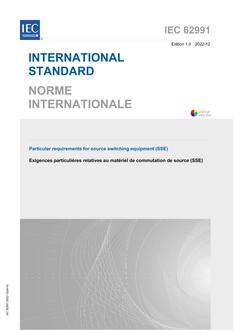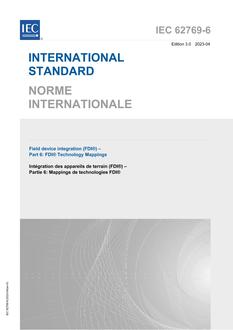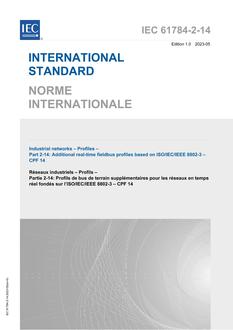
IEC 62991 Ed. 1.0 b:2022
- Comments Off on IEC 62991 Ed. 1.0 b:2022
- IEC
This International Standard applies to source switching equipment, hereafter referred to as SSE, for household and similar uses, primarily intended to be used for energy efficiency (EE) purposes with local production and/or storage of energy.
SSE is intended to be installed in low voltage prosumer electrical installations (PEI) to deliver the electrical energy:
– either to current-using equipment (direct feeding mode or island mode);
– or to the grid (reverse feeding mode).
SSE is intended to select and/or combine two power sources (e.g. selected from among grid, local power source, storage units) within an electrical energy management system (EEMS). SSE can also be used for backup supply.
NOTE 1 “Switching device for islanding” (SDFI) function is under consideration as additional requirements can be necessary. See also Figure 4 of IEC 60364-8-82:2022.
SSE is part of the fixed electrical installation.
This document applies to SSE for operation in AC single or multiphase main circuits with rated voltages not exceeding 440 V AC, frequencies of 50 Hz, 60 Hz or 50/60 Hz and rated currents not exceeding 125 A (40 A for screwless terminals). They are intended to be used in installations with prospective short circuit currents not exceeding 25 000 A. DC operations are not covered by this edition and are kept under consideration for a future revision of this document.
According to this document, SSE can be operated:
– manually (M-SSE), or
– remotely (R-SSE), or
– automatically (A-SSE), or
– a combination of the above methods of operation, e.g. manual and remote.
SSE is used to select two sources sequentially. SSE able to run two (or more) sources in parallel are not covered by this edition and are kept under consideration for a future revision of this product standard.
SSE can be operated with interlocks and/or synchronization.
NOTE 2 In some countries, it is not permitted to have synchronization of local sources with the grid for particular grid conditions, e.g. when fluctuations of the grid voltage or frequency are outside the tolerance limits.
SSE is constructed either as combined SSE (C-SSE, based on dedicated products such as circuit breakers, switches or contactors) or non-combined SSE (NC-SSE).
According to this document, C-SSE is based on switching units of the same type. SSE is intended for use in circuits where protection against electrical shock and over-current is provided according to installation rules for low voltage electrical installations, unless the SSE already contains such protective function.
SSE is normally installed by instructed persons (IEC 60050-195:2021, 195-04-02) or skilled persons (IEC 60050-195:2021, 195-04-01). SSE is normally used by ordinary persons (IEC 60005-195:2021, 195-04-03) and does not require maintenance.
The requirements of this document apply for standard environmental conditions. They are applicable to SSE intended for use in an environment with pollution degree 2 and overvoltage categories III according to IEC 60664-1:2020. SSE has at least a degree of protection IP 20 according to IEC 60529. Additional requirements can be necessary for devices used in locations having more severe environmental conditions.
SSE does not, by its nature, provide an isolation function nor the overcurrent protection. However, isolation and overcurrent protection functions as covered by relevant product standards can be provided by combined SSE.
This document does not apply to transfer switching equipment (TSE) intended to be used by skilled persons, as covered by IEC 60947-6-1:2021.
Product Details
- Edition:
- 1.0
- Published:
- 12/01/2022
- ISBN(s):
- 9782832261989
- Number of Pages:
- 296
- File Size:
- 1 file , 5.6 MB
- Note:
- This product is unavailable in Ukraine, Russia, Belarus



